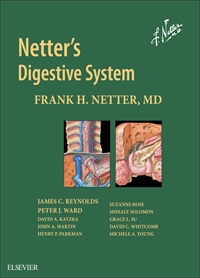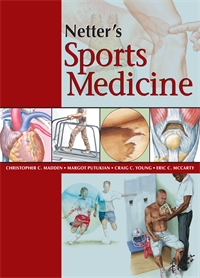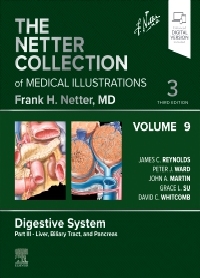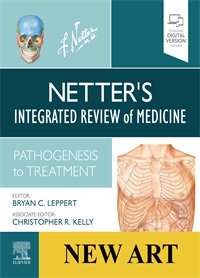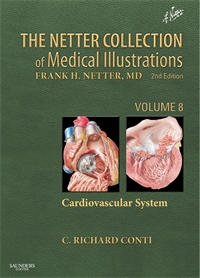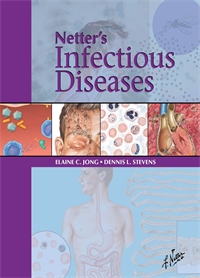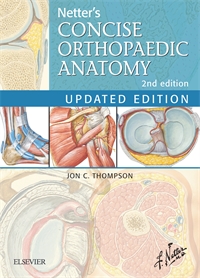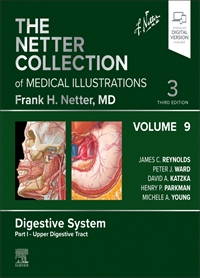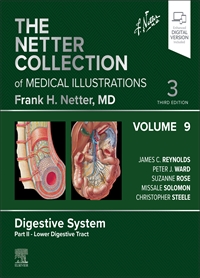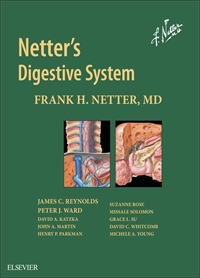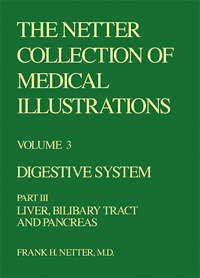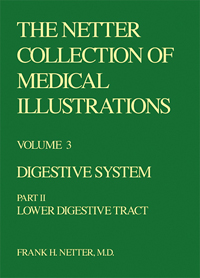Netter's Digestive System
Author: James C. Reynolds
ISBN: 9780323570510
- Page 1: Development of Gastrointestinal Tract at 14 and 16 Days
- Page 2: Development of Gastrointestinal Tract at 18 Days and 1 month
- Page 3: Development of Gastrointestinal Tract at 5 Weeks, 6 Weeks, and 2 Months
- Page 4: Development of Gastrointestinal Tract at 10 Weeks and 4 to 5 Months; Diaphragm at 9 Weeks
- Page 5: Relationships of Stomach at 2 Months; Sagittal Section at 2 to 3 Months
- Page 6: Sagittal Sections at 3 to 4 Months Compared With Adult
- Page 7: Regions of the Abdomen
- Page 8: Bony Framework of Abdominopelvic Cavity
- Page 9: Anterior Abdominal Wall: Superficial Dissection
- Page 10: Anterior Abdominal Wall: Intermediate Dissection
- Page 11: Anterior Abdominal Wall: Deep Dissection
- Page 12: Posterolateral Abdominal Wall
- Page 13: Anterior Abdominal Wall: Internal View Anterolateral Abdominal Wall
- Page 14: Inguinal Region: Dissections
- Page 15: Inguinal Canal and Spermatic Cord
- Page 16: Femoral Sheath and Inguinal Canal
- Page 17: Posterior Wall of Abdominal Cavity
- Page 18: Diaphragm
- Page 19: Pelvic Diaphragm: Male
- Page 20: Abdominal Wall and Viscera: Para Median (Para Sagittal) Section
- Page 21: Schematic Cross Section of Abdomen at Middle T12
- Page 22: Cross Section at L3, 4
- Page 23: Peritoneum of Posterior Abdominal Wall
- Page 24: Omental Bursa: Stomach Reflected
- Page 25: Pelvic Contents: Male
- Page 26: Pelvic Contents: Female
- Page 27: Endopelvic Fascia and Potential Spaces
- Page 28: Sagittal Section of Fascial Planes
- Page 29: Ischioanal Fossae
- Page 30: Actual and Potential Perineopelvic Spaces
- Page 31: Actual and Potential Perineopelvic Spaces (Continued)
- Page 32: Arteries of Posterior Abdominal Wall
- Page 33: Arteries of Anterior Abdominal Wall
- Page 34: Veins of Anterior Abdominal Wall
- Page 35: Veins of Posterior Abdominal Wall
- Page 36: Lymph Drainage of the Abdomen
- Page 37: Thoracoabdominal Nerves
- Page 38: Nerves of Anterior Abdominal Wall
- Page 39: Lumbosacral and Coccygeal Plexuses
- Page 40: Nerves of Posterior Abdominal Wall
- Page 41: Nerves of Perineum: Male
- Page 42: Overview of the Digestive System
- Page 43: Overview of Control Mechanisms
- Page 44: Overview of Control Mechanisms (Continued)
- Page 45: Brain-Gut Interactions and Visceral Reflexes
- Page 46: Enteric Nervous System
- Page 47: Visceral Referred Pain
- Page 48: Visceral Referred Pain (CONTINUED)
- Page 49: Gastrointestinal Hormones
- Page 50: Muscosal Defense Mechanisms
- Page 51: Intestinal Housekeeper
- Page 52: Gut Immune System
- Page 53: Mucosal Cellular Defense Mechanisms
- Page 54: Microbiome
- Page 55: Adverse Effects of Medications on the Upper Digetive System
- Page 56: Hunger and Appetite
- Page 57: Disturbances of Hunger and Appetite
- Page 58: Overview of Gastrointestinal Bleeding
- Page 59: Diagnostic Aids in Gastric Disorders
- Page 60: Overview Imaging the Upper Gastrointestinal Tract
- Page 61: Overview Imaging the Upper Gastrointestinal Tract (Continued)
- Page 62: Endoscopic Evaluation of the Upper Digestive Tract
- Page 63: Endoscopic Evaluation of the Upper Digestive Tract (CONTINUED)
- Page 64: Histologic and Cytologic Diagnosis
- Page 65: Breath and Stool Testing
- Page 66: Breath and Stool Testing (Continued)
- Page 67: Development of the Mouth and Pharynx
- Page 68: Oral Cavity
- Page 69: Mandible
- Page 70: Temporomandibular Joint
- Page 71: Floor of Mouth
- Page 72: Roof of Mouth
- Page 73: Muscles Involved in Mastication: Lateral Views
- Page 74: Muscles Involved in Mastication (Continued): Lateral and Posterior Views
- Page 75: Tongue: Dorsum of tongue and schematic stereogram
- Page 76: Tongue (Continued): Laterval Views
- Page 77: Teeth
- Page 78: Teeth (Continued)
- Page 79: Salivary Glands
- Page 80: Sections Through Mouth and Jaw
- Page 81: Fauces
- Page 82: Histology of Mouth and Pharynx
- Page 83: Pharynx: Median Section
- Page 84: Pharynx: Opened Posterior View
- Page 85: Bony Framework of Mouth and Pharynx
- Page 86: Musculature of Pharynx: Sagittal Section
- Page 87: Musculature of Pharynx: Lateral View
- Page 88: Musculature of Pharynx: Partially Opened Posterior View
- Page 89: Blood Supply of Mouth and Pharynx: Arteries of Oral and Pharyngeal Regions
- Page 90: Blood Supply of Mouth and Pharynx (Continued): Maxillary Artery
- Page 91: Venous Drainage of Mouth and Pharynx
- Page 92: Lymphatic Drainage of Mouth and Pharynx: Lymph Vessels and Nodes of Head and Neck
- Page 93: Lymphatic Drainage of Mouth and Pharynx (Continued): Lymph Vessels and Nodes of Pharynx and Tongue
- Page 94: Nerve Supply of Mouth and Pharynx: Nerves of Oral and Pharyngeal Regions
- Page 95: Nerve Supply of Mouth and Pharynx (Continued): Afferent Innervation of Oral Cavity and Pharynx
- Page 96: Autonomic Innervation of Mouth and Pharynx
- Page 97: Diagnositic Approach to Oral Lesoins
- Page 98: Congenital Anomalies of Oral Cavity
- Page 99: Dental Abnormalitles
- Page 100: Dental Abnormalitles (Continued)
- Page 101: Periodontal Disease
- Page 102: Odontogenic Infections: Their Spread and Abscess Formation: Origins and Pathways of Infection
- Page 103: Odontogenic Infections: Their Spread and Abscess Formation (Continued): Abscess Formation
- Page 104: Gingivitis
- Page 105: Manifestation of Tongue: Fissured tongue, hairy tongue, median rhmboid glossitis
- Page 106: Manifestation of Tongue: Amyloid tongue, Luetic glossitis, geographic tongue, megaloglossia
- Page 107: Leukoplakia
- Page 108: Effects of Iatrogenic Agents on Oral Mucosa
- Page 109: Abnormalities of Temporomandibular Joint
- Page 110: Inflammations of Salivary Glands
- Page 111: Oral Manifestations in Systemic Infections
- Page 112: Oral Manifestations of Gastrointestinal Diseases
- Page 113: Oral Manifestations of Rheumatic Diseases
- Page 114: Oral Manifestations Related to Endocrine System
- Page 115: Oral Manifestations in Nutritional Deficiencies
- Page 116: Oral Manifestations of Hematologic Diseases
- Page 117: Oral Manifestations in Various Skin Conditions
- Page 118: Oral Manifestations in Various Skin Conditions (Continued)
- Page 119: Oral Manifestations of Immunocompromised Conditions
- Page 120: Neurogenic Disorders of Mouth and Pharynx
- Page 121: Infections of Pharynx
- Page 122: Allergic Conditions of Pharynx
- Page 123: Cysts of Jaw and Oral Cavity
- Page 124: Cysts of Jaw and Oral Cavity (CONTINUED)
- Page 125: Benign Tumors of Oral Cavity
- Page 126: Benign Tumors of Oral Cavity (CONTINUED)
- Page 127: Benign Tumors of VALLECULA AND ROOT OF TONGUE (HYPOPHARYNX)
- Page 128: Benign Tumors of the Salivary Glands
- Page 129: Benign Tumors of oropharynx
- Page 130: Malignant Tumors of the oral cavity and oropharynx
- Page 131: Malignant Tumors Of the Salivary Glands
- Page 132: Malignant Tumors of the Jaw
- Page 133: Malignant Tumors of Hypopharynx
- Page 134: Salivary Secretion
- Page 135: Mastication
- Page 136: Mastication (CONTINUED)
- Page 137: Functional Disorders that Lead to Structural Issues
- Page 138: Functional Disorders that Lead to Structural Issues (Continued)
- Page 139: Development of the Esophagus
- Page 140: Topographic Relationships, Contours and Normal Construction of Esophagus: Esophagus In Situ
- Page 141: Topographic Relationships, Contours and Normal Construction of Esophagus (Continued): Topography and Constrictions of Espophagus
- Page 142: Musculature of Esophagus
- Page 143: Musculature of Esophagus (Continued): Pharyngoesophageal Junction
- Page 144: Esophagogastric Junction
- Page 145: Esophagogastric Junction (Continued): Diaphragmatic Crura and Orifices
- Page 146: Histology of Esophagus
- Page 146: Blood Supply of Esophagus
- Page 147: Venous Drainage of Esophagus
- Page 148: Lymphatic Drainage of Esophagus
- Page 149: Innervation of Esophagus: Nerves of Esophagus
- Page 150: Innervation of Esophagus (Continued): Intrinsic Nerves and Variations In Nerves of Esophagus
- Page 151: Intrinsic Innervation of Alimentary Tract
- Page 152: Neuroregulation of Deglutition
- Page 153: Neuroregulation of Deglutition (CONTINUED)
- Page 154: Esophageal Duplication Cysts
- Page 155: Congenital Esophageal Stenosis
- Page 156: Dysphagia Aortica and Vascular Compression
- Page 157: Plummer-Vinson Syndrome
- Page 158: Diverticula of Esophagus
- Page 159: Esophageal Atresia
- Page 160: Esophagoscopy and Endoscopic Ultrasound
- Page 161: Inferior Esophageal Ring Formation
- Page 162: Achalasia and Diffuse Esophageal Spasm
- Page 163: Congenital Diaphragmatic Hernia
- Page 164: Sliding and Paraesophageal Hernia: Hiatal Hernias
- Page 165: Sliding and Paraesophageal Hernia (Continued): Paraesophageal Hernias
- Page 166: Eosinophilic Esophagitis
- Page 167: Reflux Esophagitis
- Page 168: Foreign Bodies
- Page 169: Esophageal Strictures
- Page 170: Rupture and Perforation
- Page 171: Benign Tumors
- Page 172: Barrett's Esophagus
- Page 173: Adenocarcinoma of the Esophagus
- Page 174: Squamous Cell Carcinoma of the Esophagus
- Page 175: Diagnostic Aids in Esophageal and Gastric Disorders
- Page 176: Esophageal Varices
- Page 177: Development of the Stomach
- Page 178: Anatomy, Normal Variations and Relations of Stomach
- Page 179: Anatomy and Relations of Duodenum
- Page 180: Mucous Membrane of Stomach
- Page 181: Musculature of Stomach
- Page 182: Duodenal Bulb and Mucosal Surface of Duodenum
- Page 183: Structures of Duodenum
- Page 184: Duodenal Fossae and Ligament of Treitz
- Page 185: Blood Supply of Stomach and Duodenum: Arteries of Stomach, Liver, and Spleen
- Page 186: Blood Supply of Stomach and Duodenum (Continued): Arteries of Liver, Pancreas, Duodenum, and Spleen
- Page 187: Blood Supply of Stomach and Duodenum (Continued): Arteries of Stomach, Duodenum, Pancreas, and Spleeen
- Page 188: Blood Supply of Stomach and Duodenum (Continued): Arteries of Duodenum and Head of Pancreas
- Page 189: Blood Supply of Stomach and Duodenum (Continued): Hepatic Artery Variations
- Page 190: Collateral Circulation of Upper Abdominal Organs
- Page 191: Venous Drainage of Stomach and Duodenum
- Page 192: Lymphatic Drainage of Stomach
- Page 193: Innervation of Stomach and Duodenum: Autonomic Innervation of Stomach and Duodenum
- Page 194: Innervation of Stomach and Duodenum (Continued): Autonomic Innervation of Stomach and Duodenum (Continued)
- Page 195: Innervation of Stomach and Duodenum (Continued): Autonomic Innervation of Stomach and Duodenum: Schema
- Page 196: Normal Gastric Neuromuscular Physiology
- Page 198: Mechanism of Gastric Acid Secretion
- Page 200: Digestive Activity of Stomach
- Page 201: Neuroregulation of Gastric Activity
- Page 202: Neuroregulation of Gastric Activity (Continued): Enteric Nervous System
- Page 203: Factors Influencing Gastric Activity: Local Factors
- Page 204: Factors Influencing Gastric Activity (Continued): Systemic Factors
- Page 205: Hormonal Factors Influencing Gastric Activity
- Page 206: Functional Changes in Gastric Motility and Secretion in Gastric Diseases
- Page 207: Pyloric Obstruction, Effects of Vomiting
- Page 208: Nausea and Vomiting
- Page 209: Nausea and Vomiting (Continued)
- Page 211: Aerophagia and Belching
- Page 212: Endoscopic Evaluation of the Stomach: Upper Endoscopy
- Page 213: Diagnostic Aids in Gastric Disorders: Gastric Emptying Scintigraphy
- Page 214: Diagnostic Aids in Gastric Disorders: Antroduodenal Manometry
- Page 215: Diagnostic Aids in Gastric Disorders: Electrogastrography
- Page 216: Gastric Analysis
- Page 217: Helicobacter Pylori infection: Etiology and Pathogenesis of Helicobacter Pylori
- Page 218: Paraesophageal Hernia and Gastric Volvulus
- Page 219: Hypertrophic Pyloric Stenosis
- Page 220: Diverticulum of Stomach; Gastroduodenal Prolapse
- Page 221: Traumatic injuries of the Stomach
- Page 222: Gastritis
- Page 223: Acute Gastric Ulcer
- Page 224: Subacute Ulcer of Stomach
- Page 225: Chronic Gastric Ulcer
- Page 226: Cameron Lesions and Disorders of the Cardia
- Page 227: Giant Gastric Ulcer
- Page 228: Gastroparesis
- Page 229: Gastric Electrical Stimulation for Gastroparesis
- Page 230: Functional Dyspepsia
- Page 231: Peptic Ulcer: Duodenitis and Ulcer of Duodenal Bulb
- Page 232: Peptic Ulcer: Duodenal Ulcers Distal to Duodenal Bulb, Multiple Ulcers
- Page 233: Complications of Gastric and Duodenal Ulcers
- Page 234: Complications of Gastric and Duodenal Ulcers (Continued)
- Page 235: Complications of Gastric and Duodenal Ulcers (Continued)
- Page 236: Complications of Gastric and Duodenal Ulcers (Continued)
- Page 237: Healing of Gastric Ulcer
- Page 238: Benign Tumors of Stomach: Gastric Polyps
- Page 239: Benign Tumors of Stomach (Continued)
- Page 240: Carcinoma of Stomach: Near Cardia and in Fundus
- Page 241: Carcinoma of Stomach: Early Carcinoma
- Page 242: Carcinoma of Stomach: Adenocarcinoma of Stomach
- Page 243: Carcinoma of Stomach: Scirrhous Carcinoma
- Page 244: Carcinoma of Stomach: Ulcerating Carcinoma
- Page 245: Carcinoma of Stomach: Spread of Carcinoma
- Page 246: Principles of Operative Procedures: Partial Gastrectomy and Billroth Anastamoses
- Page 247: Principles of Operative Procedures (CONTINUED)
- Page 248: Bariatric Surgery
- Page 249: Postgastrectomy Complications
- Page 250: Complications of Gastrectomy (Bariatric Surgery) for Obesity
- Page 251: Blood Supply of Small and Large Intestines: Arteries of Small Intestine
- Page 252: Blood Supply of Small and Large Intestines: (CONTINUED): Arteries of Large Intestine
- Page 253: Venous Drainage of Small and Large Intestines: Veins of Small Intestine
- Page 254: Venous Drainage of Small and Large Intestines: (CONTINUED): Veins of Large Intestine
- Page 255: Venous Drainage of Small and Large Intestines: (CONTINUED): Veins of Rectum and Anal Canal: Female
- Page 256: Innervation of Small and Large Intestines: Autonomic Reflex Pathways: Schema
- Page 257: Innervation of Small and Large Intestines: (CONTINUED): Intrinsic Autonomic Plexuses of Intestine: Schema
- Page 258: Innervation of Small and Large Intestines: (CONTINUED): Autonomic Innervation of Small and Large Intestines: Schema
- Page 259: Innervation of Small and Large Intestines: (CONTINUED): Autonomic Innervation of Small Intestine
- Page 260: Innervation of Small and Large Intestines: (CONTINUED): Autonomic Innervation of Large Intestine
- Page 261: Secretory, Digestive and Absorptive Functions of Small and Large Intestines: Digestion of Protein
- Page 262: Secretory, Digestive and Absorptive Functions of Small and Large Intestines: (CONTINUED): Digestion of Carbohydrates
- Page 263: Secretory, Digestive and Absorptive Functions of Small and Large Intestines: (CONTINUED): Digestion of Fat
- Page 264: Secretory, Digestive and Absorptive Functions of Small and Large Intestines: (CONTINUED): Secretory, Digestive, and Absorptive Functions of the Colon and Colonic Flora
- Page 265: Overview of Gastrointestinal Hemorrhage: Causes of Gastrointestinal Hemorrhage
- Page 266: Overview of Gastrointestinal Hemorrhage: (Continued): Management of Gastrointestinal Hemorrhage
- Page 267: Laparoscopic Peritoneoscopy
- Page 268: The "Acute Abdomen": Causes of Acute Abdomen
- Page 269: The "Acute Abdomen" (CONTINUED): Acute Abdomen: Thoracic, Retroperitoneal, Systemic, Abdominal Wall
- Page 270: Overview of Digestive Tract Obstructions
- Page 271: Overview of Digestive Tract Obstructions (CONTINUED): Acquired Causes of Obstruction
- Page 272: Acute Peritonitis
- Page 273: Chronic Peritonitis
- Page 274: Cancer of the Peritoneum
- Page 275: Abdominal Wounds: Blast Injuries
- Page 276: Physiology of Gastroenteric Stomas
- Page 277: Physiology of Gastro-Enteric Stomas (CONTINUED)
- Page 278: Development of the Small Intestine
- Page 279: Topography and Relations of Small Bowel
- Page 280: Structure of Small Intestine: Mucosa and Musculature of Duodenum
- Page 281: Structure of Small Intestine (Continued): Small Intestine Microscopic Structure
- Page 282: Structure of Small Intestine (Continued): Epithelium of the Small Intestine
- Page 283: Blood Supply of Small Intestine
- Page 284: Lymph Drainage of Small Intestine
- Page 285: Motility of Small Intestine: Motility and Dysmotility of the Small Intestine
- Page 286: Motility of Small Intestine (CONTINUED): Gradient and Ileocecal Sphincter
- Page 287: Gastro-Intestinal Hormones
- Page 288: Pathophysiology of Small Intestine
- Page 289: Tests for Small-Bowel Function: Wireless Motility Capsule
- Page 290: Tests for Small-Bowel Function (CONTINUED): Capsule endoscopy
- Page 291: Congenital Intestinal Obstruction: Intestinal Atresia, Malrotation of Colon, Volvulus of Midgut: Congenital Intestinal Atresia
- Page 292: Congenital Intestinal Obstruction: Intestinal Atresia, Malrotation of Colon, Volvulus of Midgut (continued): Malrotation of Colon and Volvulus of Midgut
- Page 293: Congenital Intestinal Obstruction: Meconium Illeus
- Page 294: Diaphragmatic Hernia: Sites of Diaphragmatic Hernias and Herniation of Abdominal Viscera
- Page 295: Diaphragmatic Hernia (CONTINUED): Thoracic Approach To Repair Of Diaphragmatic Hernia
- Page 296: Intussusception
- Page 297: Omphalocele
- Page 298: Duplications of Alimentary Tract
- Page 299: Meckel's Diverticulum: Variants of Vitelline Duct Remnants
- Page 300: Meckel's Diverticulum: Complications of Meckel Diverticulum and Vitelline Duct Remnants
- Page 301: Diverticula of Small Intestine
- Page 302: Celiac disease: Celiac Disease and Malabsorption
- Page 303: Celiac disease (Continued): Endoscopic and Histologic Findings
- Page 304: Tropical sprue
- Page 305: Whipples Disease (Intestinal Lipodystrophy)
- Page 306: Bacterial overgrowth
- Page 307: Carbohydrate Malabsorption, Including Lactose Malabsorption
- Page 308: Lymphangiectasia and Abetalipoprotein Deficiency
- Page 309: Eosinphilic Gastroenteritis
- Page 310: Cronkhite-Canada and Other Rare Diarrheal Disorders
- Page 311: Crohn's Disease: Imaging and Regional Variations
- Page 312: Crohn's Disease (CONTINUED): Fistulizing (Penetrating) Crohn Disease
- Page 313: Crohn's Disease (CONTINUED): Extraintestinal Manifestations in Crohn Disease
- Page 314: Typhoid Fever: Typhoid Fever: Transmission and Pathologic Lesions
- Page 315: Typhoid Fever (CONTINUED): Typhoid Fever: Paratyphoid Fever, Enteric Fever
- Page 316: Infectious Enteritis: Viral Enteritis
- Page 317: Infectious Enteritis (CONTINUED): Food Poisoning: Infection Type
- Page 318: Infectious Enteritis (CONTINUED): Food Poisoning: Toxin Type
- Page 319: Infectious Enteritis (CONTINUED): Reactive Arthritis
- Page 320: HIV/AIDS Enteropathy
- Page 321: Post-transplant Lymphoproliferative Disorder
- Page 325: Abdominal and Intestinal Tuberculosis: Appearance of Mucosa
- Page 327: Abdominal and Intestinal Tuberculosis (Continued): Chronic Peritonitis
- Page 328: Mycobacteria Avium Intracellulari
- Page 329: Small Bowel Manifestations of Systemic Diseases: Connective Tissue Disorder and Dermatological Diseases
- Page 330: Small Bowel Manifestations of Systemic Diseases (CONTINUED): Miscellaneous Disorders
- Page 331: Intestinal Obstruction: Obstruction and Adynamic Ileus of the Small Intestine
- Page 332: Intestinal Obstruction (Continued): Computed Tomography of Small Intestine Obstruction
- Page 333: Vascular malformation of small intestine and other causes of small intestinal bleeding: Small Intestinal Bleeding
- Page 334: Vascular malformation of small intestine and other causes of small intestinal bleeding (CONTINUED): Angiodysplasias and Pigmentation
- Page 335: Indirect and Direct Inguinal Hernias: Indirect Inguinal Hernia
- Page 336: Indirect and Direct Inguinal Hernias (CONTINUED): The Funicular Process and Hernia in Infancy
- Page 337: Indirect and Direct Inguinal Hernias (CONTINUED): Tension-free Hernia and McVay Repairs
- Page 338: Indirect and Direct Inguinal Hernias (CONTINUED): Transabdominal Preperitoneal and Totally Extraperitoneal Approaches to Inguinal Hernia
- Page 339: Femoral Hernia: Anatomy of Femoral Hernia
- Page 340: Femoral Hernia (CONTINUED): Surgical Repair of Femoral Hernia
- Page 341: Complications of Inguinal and Femoral Hernias
- Page 342: Special Forms of Hernia
- Page 343: Ventral Hernia
- Page 344: Lumbar and Obturator Hernias
- Page 345: Sciatic and Perineal Hernias
- Page 346: Internal Hernia
- Page 347: Abdominal Wounds of Small Intestine
- Page 348: Abdominal Wounds of Mesentery
- Page 349: Abdominal Wounds Resulting from Blast Injuries
- Page 350: Mesenteric Vascular Occlusion: Thrombosis of Mesenteric Artery
- Page 351: Mesenteric Vascular Occlusion (CONTINUED): Thrombosis of Mesenteric Vein
- Page 352: Superior Mesenteric Syndrome
- Page 353: Celiac artery compression syndrome (Median Arcuate Ligament Syndrome)
- Page 354: Cancer of the Peritoneum (Peritoneal Carcinomatosis)
- Page 355: Familial Mediterranean Fever and Related Syndromes
- Page 356: Familial Mediterranean Fever and Related Syndromes (CONTINUED)
- Page 357: Laparoscopy
- Page 358: Giardiasis
- Page 359: Benign Tumors of Small Intestine
- Page 360: Benign Tumors of Small Intestine (CONTINUED)
- Page 361: Carcinoid
- Page 362: Peutz-Jeghers Syndrome
- Page 363: Malignant Tumors of Small Intestine
- Page 364: Malignant Tumors of Small Intestine (CONTINUED)
- Page 370: Development of the Large Intestine
- Page 371: Ileocecal Region: External features of the ileocecal region
- Page 372: Ileocecal Region (Continued): Internal features of the ileocecal region
- Page 373: Vermiform Appendix
- Page 374: Topography and Relations of Colon: Mesenteric Relations of Intestines
- Page 375: Topography and Relations of Colon (Continued): Typical Sigmoid Colon and Variations
- Page 376: Structure of Colon
- Page 377: Rectum and Anal Canal: Rectum In Situ: Female and Male
- Page 378: Rectum and Anal Canal (Continued): Structure of Rectum and Anal Canal
- Page 379: Rectum and Anal Canal (Continued): Histology of the Anal Canal
- Page 380: Anorectal Musculature: Continuity With Sigmoid and Cross Section
- Page 381: Anorectal Musculature (Continued): External Anal Sphincter Muscle: Perineal Views
- Page 382: Anorectal Musculature (Continued): Muscles of the Pelvic Floor With Common Variations In External Sphincter
- Page 383: Anorectal Musculature (Continued): Pelvic Diaphragm: Male
- Page 384: Blood Supply of the Large Intestine: Variations In Cecal and Appendicular Arteries
- Page 385: Blood Supply of the Large Intestine (Continued): Variations In Colic Arteries
- Page 386: Blood Supply of the Large Intestine (Continued): Variations In Colic Arteries (Continued)
- Page 387: Blood Supply of the Large Intestine (Continued): Arteries of Rectum and Anal Canal: Male
- Page 388: Lymph Drainage of Large Intestine
- Page 389: Physical Examination
- Page 390: Radiologic and Imaging Studies CT vs MRI in Abdominal Studies
- Page 391: Colonoscopy
- Page 392: Biopsy and Cytology: Endoscopic Biopsy
- Page 393: Congenital Intestinal Obstruction: Anorectal Malformations: Imperforate Anus
- Page 394: Congenital Intestinal Obstruction: Anorectal Malformations (continued): Perineal Approach To Imperforate Anus
- Page 395: Congenital Intestinal Obstruction: Management of Anorectal Malformations
- Page 396: Congenital Intestinal Obstruction: Hirschsprung's Disease: Typical Distention and Hypertrophy
- Page 397: Congenital Intestinal Obstruction: Hirschsprung's Disease (Continued): AGANGLIONIC MEGACOLON
- Page 398: Congenital Intestinal Obstruction: Hirschsprung's Disease (Continued): Surgical Repair
- Page 399: Diverticulosis of Colon
- Page 400: Diverticulitis
- Page 401: Volvulus of Sigmoid
- Page 402: Volvulus of Cecum
- Page 403: Intussusception
- Page 404: Diseases of the Appendix
- Page 405: Abdominal Wounds: Colon: Exteriorization of Sigmoid Wound
- Page 406: Abdominal Wounds: Colon: Wound of Hepatic Flexure
- Page 407: Abdominal Wounds: Rectum
- Page 408: Anal Melanoma, Radiation Injury, and Typhlitis
- Page 409: Foreign Bodies in Anus and Colon
- Page 410: Proctologic Conditions: Hemorrhoids
- Page 411: Proctologic Conditions: Prolapse and Procidentia
- Page 412: Proctologic Conditions: Papillitis, Cryptitis, Adenomatous Polyps, Villous Tumor, Fissure, and Pruritus Ani
- Page 413: Proctologic Conditions: Anorectal Abscess and Fistula
- Page 414: Proctologic Conditions: Sexually Transmitted Diseases
- Page 415: Parasitic Diseases: Trichuriasis
- Page 416: Parasitic Diseases: Ascariasis
- Page 417: Parasitic Diseases: Enterobiasis
- Page 418: Parasitic Diseases: Strongyloidiasis
- Page 419: Parasitic Diseases: Necatoriasis and Ancylostomiasis
- Page 420: Parasitic Diseases: Taeniasis Caused by Taenia saginata
- Page 421: Parasitic Diseases: Taeniasis Caused by Taenia solium (Cysticercus cellulosae)
- Page 422: Parasitic Diseases: Hymenolepiasis nana
- Page 423: Parasitic Diseases: Diphyllobothriasis
- Page 424: Helminths and Protozoa Infesting the Human Intestine: Ova of Helminth Parasites and Pseudoparasites and Rhabditiform Larvae
- Page 425: Helminths and Protozoa Infesting the Human Intestine (Continued): Giardia Iamblia and Other Protozoans
- Page 426: Amebiasis: Fecal-Oral Spread of Disease
- Page 427: Amebiasis (CONTINUED): Histology and Scope images of amebiasis
- Page 428: Disorders Seen with HIV/AIDS
- Page 429: Clostridium Difficile Infection
- Page 430: Food Poisoning and Infectious Diarrhea
- Page 431: Ulcerative Colitis: Endoscopic Images and Histology
- Page 432: Ulcerative Colitis (Continued): Etiologic Factors, Complications
- Page 433: Ulcerative Colitis (Continued): Ileosstomy
- Page 434: Ulcerative Colitis (Continued): Ileal Pouch Anal Anastomosis (IPAA) and Pouchitis
- Page 435: Crohn's Disease: Histology and Endoscopy
- Page 436: Crohn's Disease (Continued): Imaging and Strictureplasty
- Page 437: Microscopic colitis
- Page 438: Diversion colitis
- Page 439: Ischemic Colitis
- Page 440: Angioedema
- Page 441: Strictures from NSAIDs
- Page 442: Visceral Reflexes
- Page 443: Motility of the Large Intestine
- Page 444: Normal Defecation
- Page 445: Motility Testing: 3D High Resolution Anorectal Manometry with Balloon Expulsion Testing
- Page 446: Pathophysiology of Defecation: Factors Affecting Normal Defecation
- Page 447: Diarrhea
- Page 448: Overview of Constipation
- Page 449: Chronic Idiopathic Constipation
- Page 450: Irritable Bowel Syndrome, Constipation Predominant
- Page 451: Pelvic Floor Dysfunction and Constipation
- Page 452: Fecal Incontinence
- Page 453: Medical Therapy for Motility Disorders: Laxatives
- Page 454: Chronic Colonic Pseudoobstruction and Toxic Megacolon: Toxic Megacolon
- Page 455: Ogilvie syndrome
- Page 456: Colonic Involvement in Systemic Diseases: Colinic Involvement in Diabetes and Scleroderma
- Page 457: Colonic Involvement in Systemic Diseases: Colinic Involvement in Amyloidosis and Sarcoidosis
- Page 458: Malignant Tumors of Large Intestine
- Page 459: Malignant Tumors of Large Intestine (CONTINUED)
- Page 460: Malignant Tumors of Large Intestine (CONTINUED)
- Page 461: Polyposis Syndromes: Familial Polyposis
- Page 462: Polyposis Syndromes (CONTINUED): Multiple Polyposis
- Page 463: Colon Cancer Prevention
- Page 464: Genetics of Colon Cancer
- Page 465: Development of the Liver
- Page 466: Development of Liver and its Venous System
- Page 467: Prenatal and Postnatal Circulation
- Page 468: Topography of Liver
- Page 469: Surfaces and Bed of Liver
- Page 470: Lesser Omentum, Variations in Form of Liver
- Page 471: Cellular Elements of Liver
- Page 472: Intrahepatic Structures: Liver Structure: Schema
- Page 473: Intrahepatic Structures: Vascular Ductal Relations and Liver Lobules
- Page 474: Intrahepatic Structures: Intrahepatic Vascular System
- Page 475: Vessel and Duct Distribution, Liver Segments
- Page 476: Arterial Blood Supply of Liver, Biliary System and Pancreas
- Page 477: Hepatic Artery Variations
- Page 478: Cyctic Artery and Its Variations
- Page 479: Portal Vein Tributaries, Portacaval Anastomoses
- Page 480: Portal Vein: Variations and Anomalies
- Page 481: Lymphatic Drainage of Liver and Bile Tract
- Page 482: Innervation of Liver and Bile Tract
- Page 483: Congenital and Familial Hyperbilirubinemias
- Page 484: Congenital Anomalies
- Page 485: Liver Functions
- Page 487: Innate Immune System and the Liver
- Page 488: Prothrombin Formation
- Page 489: Physical Diagnosis of Liver Disease
- Page 490: Liver Function Tests
- Page 491: Bilirubin and Bile Acid Metabolism: Normal Formation and Circulation of Bile Pigment
- Page 492: Bilirubin and Bile Acid Metabolism (Continued): Bile Acid Circulation and Metabolism: Enterohepatic Circulation and Cellular Mechanisms of Metabolism
- Page 493: Bilirubin and Bile Acid Metabolism (Continued): Hepatic Protein and Bile Acid Metabolism: Normal Serum Protein and Clotting Factors and Cholestasis
- Page 494: Liver Biopsy: Percutaneous Suction and Laparoscopic Techniques
- Page 495: Noninvasive Assessments for Hepatic Fibrosis
- Page 496: Imaging Studies of the Liver: Ultrasound
- Page 497: Imaging Studies of the Liver (CONTINUED): Computed Tomography and Magnetic Resonance Imaging
- Page 498: Liver Disease in Pregnancy: Liver Diseases Caused by Pregnancy and Incidental to Pregnancy
- Page 499: Liver Disease in Pregnancy (Continued): HELLP Syndrome and Eclampsia
- Page 500: Trauma
- Page 501: Jaundice in the Neonatal Period: Causes of Jaundice in the Noenatal
- Page 502: Jaundice in the Neonatal Period (Continued): Manifestations of Kernicterus and Treatment
- Page 503: Congential Malpositions of Liver
- Page 504: Pathologic Features of Liver Injury
- Page 505: Pathologic Features of Regeneration and Atrophy
- Page 506: Pathologic Features of Hepatic Necrosis
- Page 507: Cirrhosis: Overview
- Page 508: Cirrhosis: Fundamental Vascular Changes
- Page 509: Cirrhosis: Clinical Manifestations
- Page 510: Portal Hypertension: Causes
- Page 511: Clinical Determination of Portal Hypertension
- Page 512: Portal Hypertension: Endoscopic approach
- Page 513: Portal Hypertension: Transjugular Intrahepatic Portal Systemic Shunt (TIPS)
- Page 514: Ascites: Pathogenesis
- Page 515: Renal Complications of Liver Disease
- Page 516: Hepatic Encephalopathy
- Page 517: Non-alcoholic fatty Liver disease (NAFLD)
- Page 518: Alcoholic Liver Disease
- Page 519: Hemosiderosis, Hemochromatosis: Overview of Iron Metabolism
- Page 520: Hemosiderosis, Hemochromatosis (Continued): Patterns of Iron Deposition in Secondary Iron Overload and Hereditary Hemochromatosis
- Page 521: Wilson Disease
- Page 522: Alpha-1-Antitrypsin Deficiency
- Page 523: Other Inherited Metabolic Disorders (von Gierke's Disease, Galactosemia, Nieman-Pick's Disease)
- Page 524: Hypoxic Conditions: Shock and Sickle Cell Anemia
- Page 525: Drug-Induced Hepatic Injuries
- Page 526: Acute Hepattitis (Hepatitis A and E)
- Page 527: Acute Hepattitis (Hepatitis A and E) (CONTINUED)
- Page 528: Hepatitis B and Hepatitis D
- Page 529: Hepatitis B and Hepatitis D (CONTINUED)
- Page 530: Hepatitis C
- Page 531: Hepatitis Caused by Herpesviridae
- Page 532: Spirochetal Infections (Weil's Disease, Syphilis)
- Page 533: Granulomatous Liver Disease: Tuberculosis
- Page 534: Granulomatous Liver Disease (CONTINUED): Sarcoidosis, Brucellosis, Histoplasmosis
- Page 535: Amebiasis
- Page 536: Echinococcus Cyst (Hydatid Disease)
- Page 537: Schistosomiasis
- Page 538: Primary Biliary Cirrhosis: Histologic features of biliary cirrhosis
- Page 539: Primary Biliary Cirrhosis (Continued): Clinical Features of Primary Billary Cirrhosis
- Page 540: Primary Sclerosing Cholangitis: Pathologic Features of Primary Sclerosing Cholangitis
- Page 541: Primary Sclerosing Cholangitis (Continued): Clinical Manifestations of Primary Sclerosing Cholangitis
- Page 542: Percutaneous Transhepatic Cholangiography and Endoscopic retrograde cholangiography
- Page 543: Autoimmune Hepatitis
- Page 544: Vascular Disturbances: Arterial
- Page 545: Vascular Disturbances: Portal Vein
- Page 546: Hepatic Vein Obstruction: Budd Chiari Syndrome
- Page 547: Vascular Disturbances: Periarteritis Nodosa, Aneurysm
- Page 548: Cardiac Liver (Congestive Hepatopathy)
- Page 549: Hematologic Malignancy and the Liver: Hodgkin’s Disease, Leukemia, Venoocclusive disease, graft vs host disease: Acute lymphoblastic (ALL) and myeloid leukemia (AML)
- Page 550: Benign Liver Tumors: Hemangioma
- Page 551: Benign Liver Tumors (CONTINUED): Focal Nodular Hyperplasia
- Page 552: Benign Liver Tumors (CONTINUED): Adenoma
- Page 553: Hepatocellular Carcinoma: Gross Features
- Page 554: Hepatocellular Carcinoma (CONTINUED): Histologic Features, and Spread of Primary Carcinoma Within the Liver
- Page 555: Nonsurgical Therapies for Localized Hepatocellular Carcinoma: Percutaneous ablation, transarterial embolization and radiotherapy
- Page 556: Cholangiocarcinoma
- Page 557: Metastatic Liver Cancer
- Page 558: Operative Procedures: Wedge Resection/Segmentectomy
- Page 559: Left Lobectomy: Left Lobectomy: Steps 1, 2, and 3
- Page 560: Left Lobectomy (Continued): Left Lobectomy: Steps 4, 5, and 6
- Page 561: Extended Right Lobectomy: Extended Right Lobectomy: Steps 1, 2, 3, and 4
- Page 562: Extended Right Lobectomy (Continued): Extended Right Lobectomy: Steps 5 and 6
- Page 563: Palliative Therapy in Inoperable Cases: Infusion of Chemotherapeutic Agents via Hepatic Artery Infusion Pump
- Page 564: Liver Transplantation
- Page 565: Liver Transplantation (Continued)
- Page 566: Development of the Gallbladder and Bile Ducts
- Page 567: Anatomy and Histology of Gallbladder and Bile Ducts
- Page 568: Variations of Extrahepatic Bile Ducts, Accessory Hepatic Ducts
- Page 569: Choledochoduodenal Junction
- Page 570: Function of Gallbladder and Choledochoduodenal Sphincter
- Page 571: Function of Gallbladder and Choledochoduodenal Sphincter (Continued): HIDA Scan
- Page 572: Sphincter of Oddi Dysfunction, Geenen’s Classification, and Sphincter of Oddi Manometry: Sphincter of Oddi Dysfunction
- Page 573: Sphincter of Oddi Dysfunction, Geenen’s Classification, and Sphincter of Oddi Manometry: Manometry Tracings and Diagnostic Criteria
- Page 574: Noninvasive Imaging of the Gallbladder and Bile Ducts
- Page 575: Invasive Imaging Modalities and Minimally Invasive Interventions of the Bile Duct: Percutaneous Cholangiography, ERCP, and MRCP
- Page 576: Invasive Imaging Modalities and Minimally Invasive Interventions of the Bile Duct (Continued): Choledocholithiasis and Cholangitis: Management of Stones
- Page 577: Congenital Anomalies: Gallbladder and Bile Ducts
- Page 578: Cholelithiasis: Stone Formation
- Page 579: Cholelithiasis: Clinical Aspects
- Page 580: Cholelithiasis: Pathologic Features, Choledocholithiasis
- Page 581: Hydrops and Empyema of Gallbladder
- Page 582: Interrelation of Gallbladder Diseases
- Page 583: Cholecystitis: Acute and Chronic
- Page 584: Cholecystitis: Later Stages and Complications
- Page 585: Perforation, Subphrenic Abscess
- Page 586: Bile Duct Fistulae
- Page 587: Biliary injuries and Cholangitis: Extrahepatic Cholangitis, Strictures, Surgical Accidents
- Page 588: Biliary injuries and Cholangitis (Continued): Open Cholecystectomy
- Page 589: Biliary injuries and Cholangitis (Continued): Laparoscopic Cholecystectomy
- Page 590: Diagnosis of Biliary Tract Disease
- Page 591: Tumors of Gallbladder
- Page 592: Tumors of Bile Ducts
- Page 593: Ampullary Tumors
- Page 594: Postcholcystectomy Syndrome
- Page 595: Development of Pancreas
- Page 596: Arterial Blood Supply of Liver, Biliary System and Pancreas
- Page 597: Anatomy and Histology of Pancreas
- Page 598: Pancreatic Ducts and Variations
- Page 599: Peritoneal Relations of Pancreas
- Page 600: Surgical Approaches to Pancreas
- Page 601: Lymphatic Drainage of Pancreas
- Page 602: Innervation of Pancreas
- Page 603: Normal Secretion of the Pancreas
- Page 604: Biochemical Changes in Acute Pancreatitis
- Page 605: Biochemical Changes in Pancreatic Obstruction
- Page 606: Laboratory Aids in Diagnosis of Pancreatic Disease
- Page 607: Congenital Anomalies of Pancreas
- Page 608: Cystic Fibrosis of Pancreas
- Page 609: Acute Pancreatitis
- Page 610: Chronic (Relapsing) Pancreatitis
- Page 611: Pancreatic Cysts
- Page 612: Malignant Tumors: Solid Tumors (Exocrine and Endocrine Neoplasms)
- Page 613: Malignant Tumors: Carcinoma, Gross Pathology, Clinical Features
- Page 614: Malignant Tumors: Histology, Metastases
